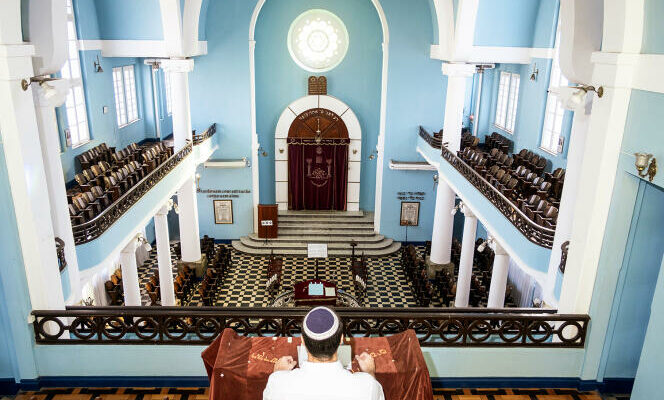The vast azure building is accessible via a narrow street, away from Belem city center. Unlike so many other historic buildings in the capital of the state of Pará, at the mouth of the Amazon, this one has hardly suffered the devastating effects of time and extreme humidity. Quite the opposite: perfectly maintained, the Sha’ar Hashamayim synagogue appears to have been inaugurated the day before.
Jews in the Amazon? As old as it is little-known, the community has seen its tranquility disturbed since the start of the war in Gaza between Israel and Hamas on October 7. Inaugurated in 1826 or 1828 (the date is debated), the Sha’ar Hashamayim is also considered to be the very first synagogue built in Brazil after independence, in 1822. With its dome, its pearly pillars and its lamps silver oil, the soon to be bicentenary place of worship retains a little oriental air.
“ Its architecture is typically Sephardic-Moorish! “, would like to point out Samuel Gabbay, 44 years old, its friendly director. The Amazon is nevertheless present in the chairs and the floor, all made from tropical wood. jatobá. The stained glass windows in green and yellow tones evoke the colors of the great forest… “We regularly receive European or Israeli tourists, who are very curious about our synagogue! “, says Samuel Gabbay.
An economic opportunity
And yet, Jews are just a drop of water in this green ocean of jungle. They would be at most five thousand out of the seventeen million inhabitants of the Brazilian Amazon (i.e. barely 0.02% of the population), mainly grouped in the metropolises of Belém and Manaus. Unlike the one hundred and twenty thousand other Jews in Brazil, the majority of whom are Ashkenazi, the latter are Sephardic and almost entirely from Morocco.
Their arrival in the Portuguese colony officially dates from 1810. “Three years earlier, Napoleon invaded Portugal and the Portuguese royal family Braganza fled to Rio under the protection of the English. In exchange, the English obtained the right for foreigners to trade freely in the colony. says Anne Benchimol, Jewish historian born in Manaus and memory of the community. “Moroccan Jews see it as an economic opportunity. Some leave for the Amazon,” explains the researcher.
Migration increased from 1850 and the famous “rubber boom”. Polyglot and well trained, the Jews of Fez or Tangier then served as intermediaries between local producers and European traders. They participated in the growth of Belem and Manaus, founded synagogues, schools and newspapers. Some members entered politics, like Eliezer Levy, who became mayor of Macapá, the large city on the Amazon estuary, during the 1930s.
You have 49.72% of this article left to read. The rest is reserved for subscribers.
